Documents: Go to download!
User Manual
- User Manual - (English)
- Quick Start Guide - (English)
- Getting to Know Your TV
- Completing the First-Time Setup
- Using the On-Screen Menu
- SmartCast Home™
- WatchFree™
- Playing USB Media
- Troubleshooting
Table of contents
User Manual Tv
Getting to Know Your TV
FRONT PANEL
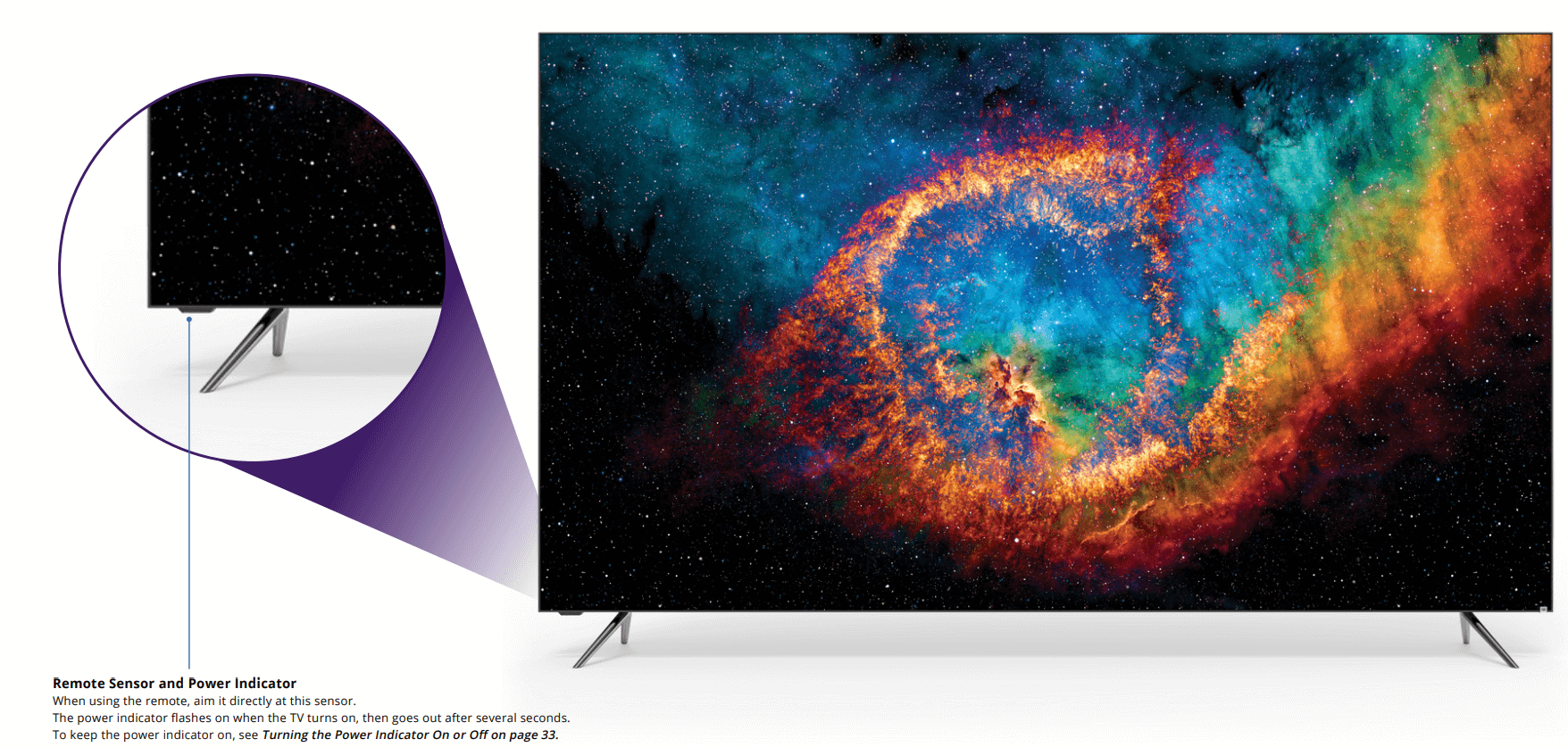
REAR PANEL
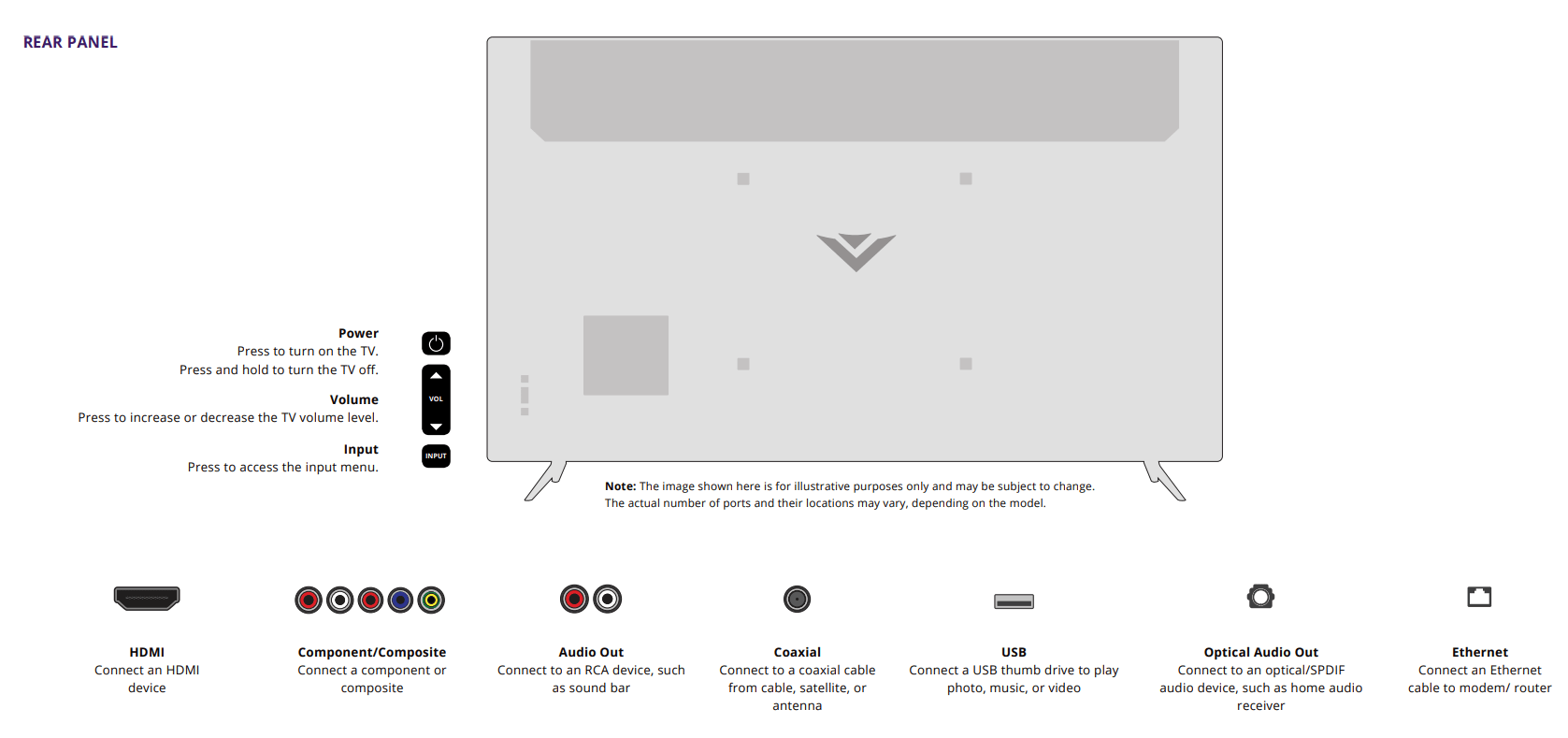
Connecting a device — AUDIO & VIDEO CABLE TYPES

Your TV can be used to display output from most devices.
- Verify that your device has a video port that matches an available port on the TV (HDMI, Composite, etc.).
- Connect the appropriate cable (not included) to the TV and the device.
- Turn the TV and your device on.
- Set the TV’s input to match the connection you used (HDMI-1, HDMI-2, etc.).
Connecting a device — AUDIO CABLE TYPES

Your TV can be output sound to an audio device, such as a receiver or sound bar.
- Verify that your device has an audio port that matches an available port on the TV (optical, RCA, etc).
- Connect the appropriate cable (not included) to the TV and the device.
- Turn the TV and your device on.
WALL-MOUNTING THE TV
First you will need a wall mount. Consult the provided table below to find the appropriate mount for your TV.
Be sure the mount you choose is capable of supporting the weight of the TV.
To install your TV on a wall:
- Disconnect any cables connected to your TV.
- Place the TV face-down on a clean, flat, stable surface. Be sure the surface is clear of debris that can scratch or damage the TV.
- If attached, remove the stands by loosening and removing the screws.
- Attach your TV and wall mount to the wall by carefully following the instructions that came with your mount. Use only with a UL-listed wall mount bracket rated for the weight/load of your TV.
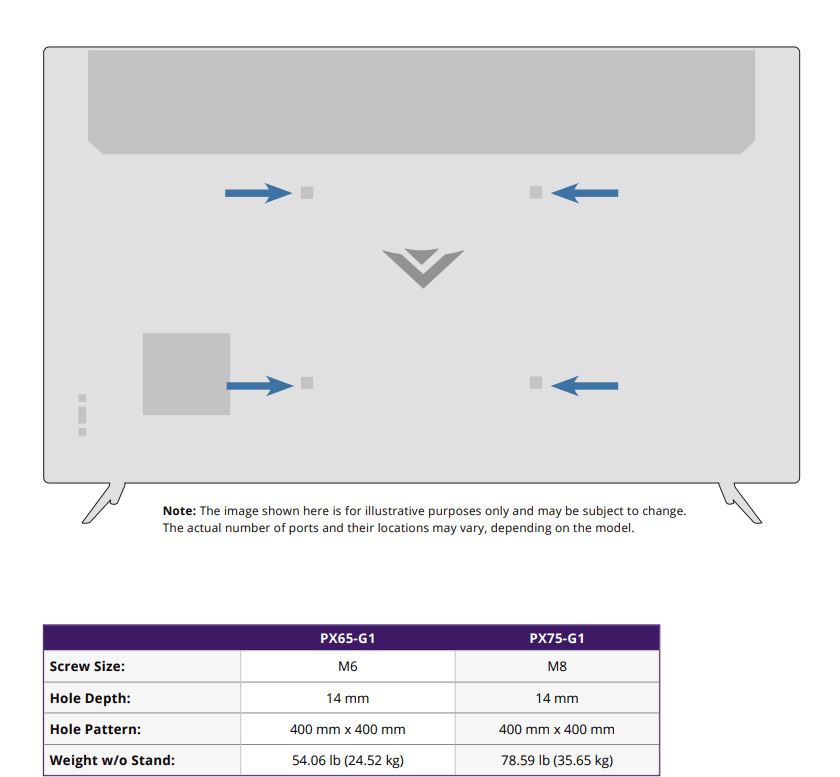
USING THE REMOTE — XRT136 (BLACK)
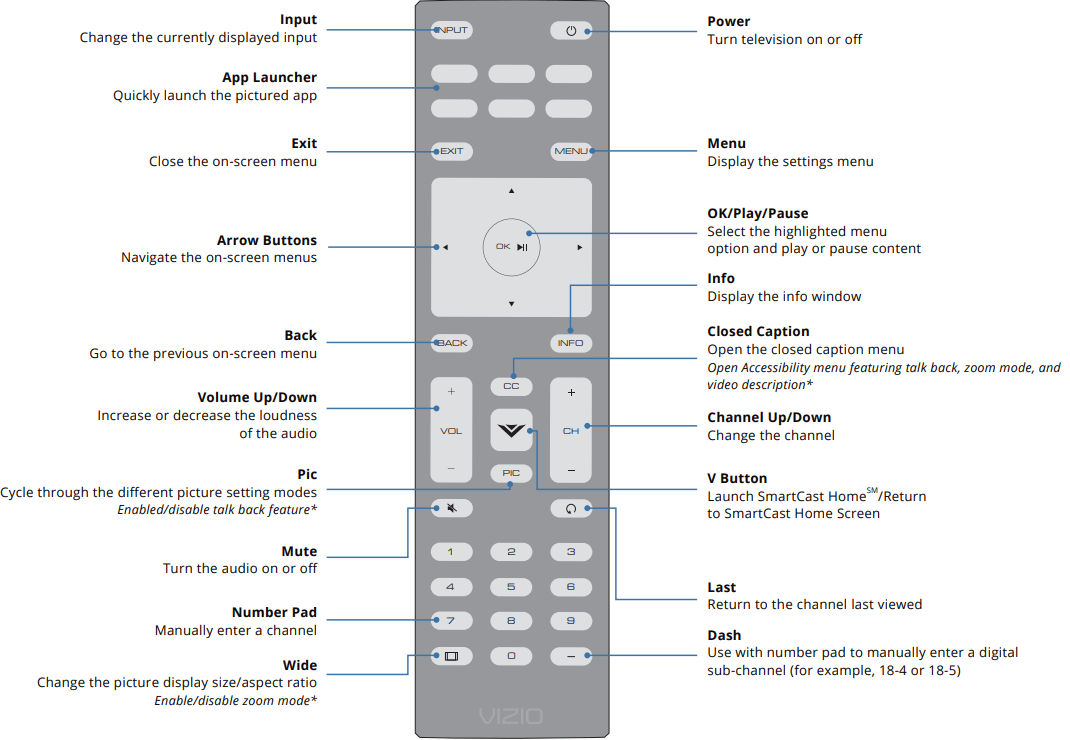
*Enabled/disabled different accessibility features by holding down each of these buttons for 5 seconds.
USING THE REMOTE — XRT150 (GALAXY GREY)
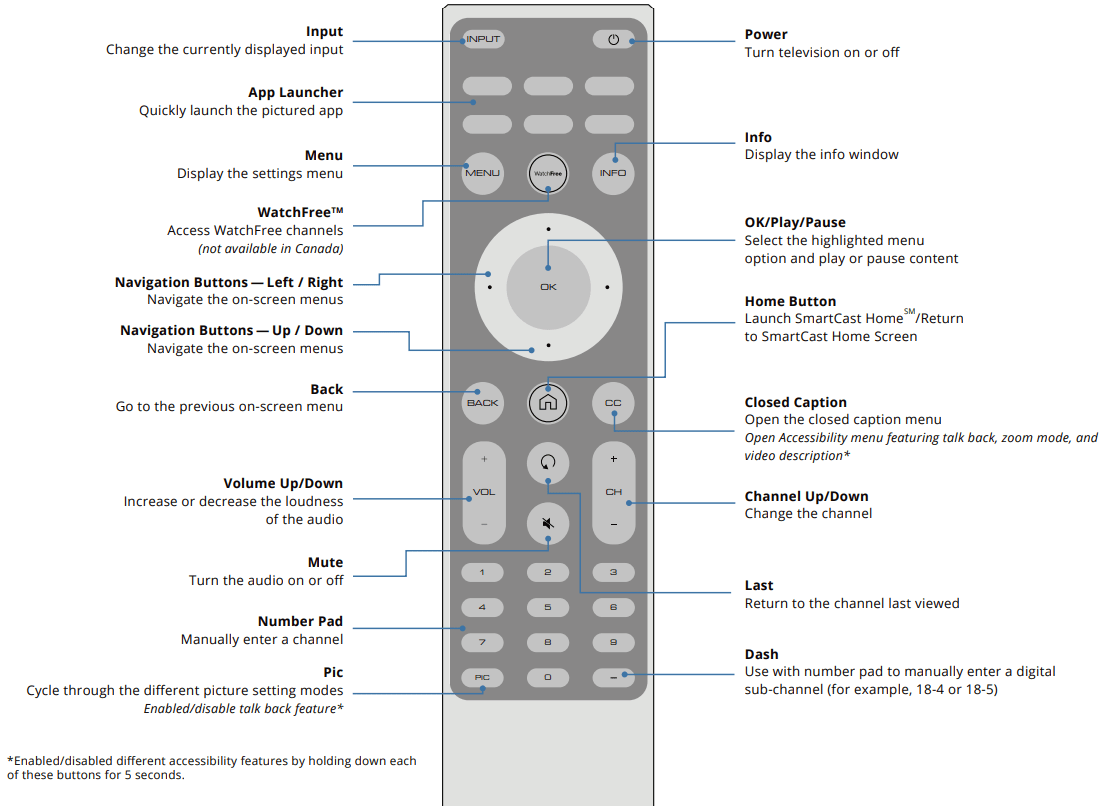
Completing the First-Time Setup
Before you begin the first-time setup:
- Your TV should be installed and the power cord should be connected to an electrical outlet.
- If you have a wireless network, have the network password ready.
- If you are connecting to your network with an Ethernet cable, connect it to the Ethernet port on the TV.
The first time you turn on the TV, the on-screen instructions will guide you through each of the steps necessary to get your TV ready for use:
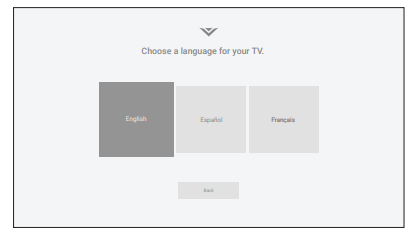
1. Choose your language.
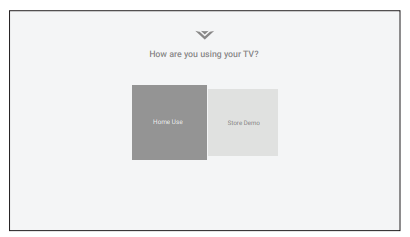
2. Choose home use.

3. Choose your country.
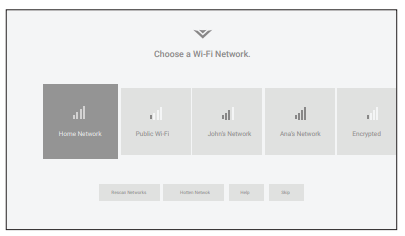
4. Choose your WI-Fi network and enter the password.
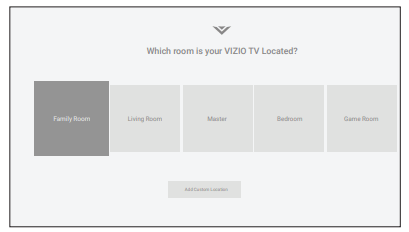
5. Name your TV.
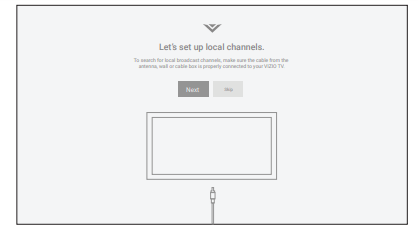
6. Scan for channels.
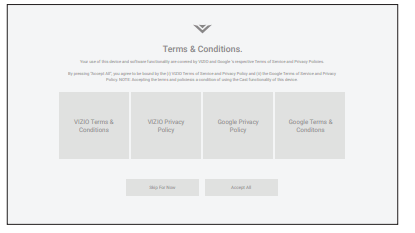
7. Accept the Terms & Conditions and register your device.

Using the On-Screen Menu
Your TV features an easy-to-use on-screen menu.
To open the on-screen menu, press the MENU button on the remote.
From this menu, you can:
- Adjust the picture settings
- Adjust the audio settings
- Adjust the network settings
- Set up timers
- Adjust the channel settings
- Set up closed captioning
- Name and adjust Inputs
- Adjust TV settings
- View the user manual

NAVIGATING THE ON-SCREEN MENU
To open the on-screen menu:
- Press the MENU button on the remote.
- Use the Navigation buttons to highlight a menu option, and press the OK button to select that option.
CHANGING THE INPUT SOURCE
External devices, such as DVD players, Blu-ray Players, and video game consoles, can be connected to your TV. To use one of these devices with your TV, you must first change the input source using the Input menu.
To change the input sources:
- Press the INPUT button on the remote. The input menu is displayed.
- Use the Navigation buttons or the INPUT button on the remote to highlight the input you wish to view. The corresponding inputs are named on the back of your TV.
- Press OK or release the INPUT button. The selected input is displayed.
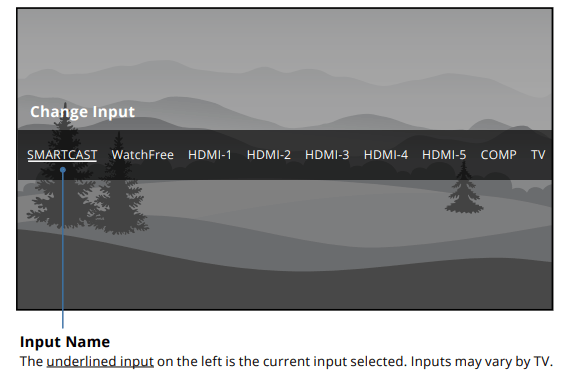
CHANGING THE SCREEN ASPECT RATIO
To change the screen aspect ratio:
- Press the WIDE
 or PIC button on the remote.
or PIC button on the remote. - Use the Navigation buttons to highlight the aspect ratio you wish to view and press OK.
Your TV can display images in different modes: Normal, Stretch, Wide, Zoom, and Panoramic.
- Normal (default) – No change to aspect ratio.
- Stretch* – When the 16:9 signal is a 4:3 image with black bars left and right, stretches to fill the screen.
- Wide – Stretches a 4:3 aspect ratio to fill 16:9 screen. If a 16:9 image, adds black bars to top and bottom.
- Zoom – Expands image both horizontally and vertically by 14%.
- Panoramic* — Stretches a 4:3 image to fill 16:9 screen with an algorithm so the center doesn’t look stretched.
Some programs have black bars on the top or sides of the screen so that the picture keeps its original shape. Examples include widescreen movies and older TV programs.
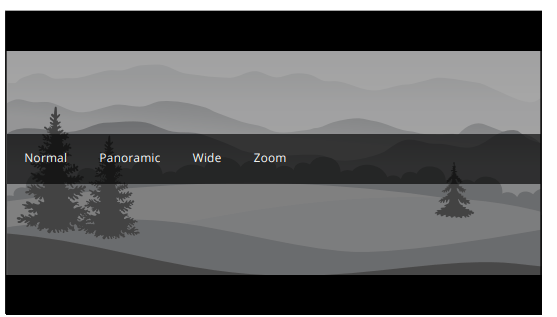
ADJUSTING THE PICTURE SETTINGS
Your TV can be adjusted to suit your preferences and viewing conditions.
To adjust the picture settings: Menu > Picture > Picture Mode
1. Use the Navigation buttons on the remote to highlight Picture Mode, then use the Left/Right Navigation buttons to change the picture mode:
- Standard — Sets the picture settings to the default settings.
- Calibrated — Sets the picture settings to values ideal for watching TV in a brightly-lit room.
- Calibrated Dark — Sets the picture settings to values ideal for watching TV in a dark room.
- Vivid — Sets the picture settings to values that produce a brighter, more vivid picture.
- Game — Reduces throughput delays and optimizes the picture settings for displaying game console output.
- Computer — Optimizes the picture settings for displaying computer output.
2. To manually change each of the picture settings, use the Up/Down Navigation buttons on the remote to highlight that picture setting, then use the Left/Right Navigation buttons to adjust the setting:
- Backlight — Adjusts the LED brightness to affect the overall brilliance of the picture. Backlight cannot be adjusted when starting from some picture modes.
- Brightness — Adjusts the black level of the picture. When this setting is too low, the picture may be too dark to distinguish details. When this setting is too high, the picture may appear faded or washed out.

- Contrast — Adjusts the white level of the picture. When this setting is too low, the picture may appear dark. When this setting is too high, the picture may appear faded or washed out. If the setting is too high or too low, detail may be difficult to distinguish in dark or bright areas of the picture.
- Color — Adjusts the intensity of the picture colors.
- Tint — Adjusts the hue of the picture. This setting is useful in adjusting the flesh tones in the picture. If flesh appears too orange, reduce the level of color before adjusting tint.
- Sharpness — Adjusts the edge sharpness of picture elements. It can be used to sharpen non-HD (high definition) content; however, it will not produce detail that does not otherwise exist.
Adjusting More Picture Settings
To adjust more picture settings: Menu > Picture > More Picture
Use the Navigation buttons to highlight the setting you wish to adjust, then press the Left/Right Navigation buttons to change the setting:
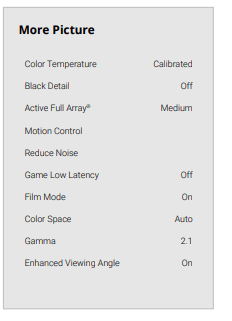
- Color Temperature — Change the white balance of the picture. Refer to the section on Adjusting the Color Temperature on page 17.
- Black Detail — Adjusts the average brightness of the picture to compensate for large areas of brightness.
- Active Full Array® — Based on the content, dynamically adjusts and balances the brightness and the contrast ratio of the picture by locally adjusting backlight zones.
- Motion Control — Reduce the motion blur of the conent with fast action.
- Reduce Noise:
- Reduce Signal Noise: Lessens artifacts in the image caused by the digitizing of image motion content.
- Reduce Block Noise: Reduces pixelation and distortion for mpeg files.
- Game Low Latency — Reduces video delay (lag) when gaming.
- Film Mode — Optimizes the picture for watching films.
- Color Space — Select Color Space for the source. Video sources uses YCbCr, but PC uses RGB.
- Gamma — Set the shape of the Gamma curve. Use lower Gamma values for bright room conditions, and higher values when it’s dark.
- Enhanced Viewing Angle — Increases the viewing angle with richer colors and a higher contrast image. This mode reduces horizontal resolution.
ADJUSTING THE AUDIO SETTINGS
To adjust the audio settings: Menu > Audio > OK
Use the Navigation buttons to highlight the setting you wish to adjust, then press Left/Right Navigation buttons to change the setting:
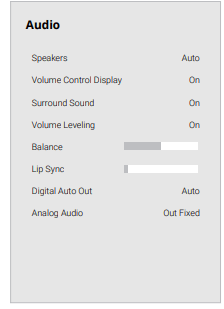
- Speakers — Turn the built-in speakers On or Off.
- Volume Control Display — Turn the on-screen volume display slider On or Off.
- Surround Sound — Surround sound uses DTS TruSurround™ to deliver an immersive surround sound experience from the TV’s internal speakers. TruSurround completes the entertainment experience by providing deep, rich bass, crisp details, and clear, intelligible dialog. Select On or Off.
- Volume Leveling — Volume leveling uses DTS TruVolume™ to maintain consistent volume levels during transitions between program content, AV formats, and input sources. Select On or Off. In a few cases, volume leveling may artificially suppress volume increases, making it difficult to hear dialog or flattening sudden noises. If this occurs, turn volume leveling off.
- Balance — Adjusts the loudness of the audio output from the left and right speakers.
TIP: When the TV speakers are set to On, DTS signals cannot be passed through digital audio outputs. - Lip Sync — Adjusts the synchronization between the display image and the accompanying audio track.
- Digital Audio Out — Changes the type of processing for digital audio out and HDMI ARC output when connected to a home theater audio system. Select Auto, PCM, Dolby D or Bitstream.
- To hear talk back when Talk Back function is enabled, digital audio out must be set to PCM.
- Analog Audio Out — Sets the volume control properties for the RCA connector when connected to a home theater audio system. Select Variable if you are controlling the volume with the TV’s volume controls, or select Fixed if an external audio device (sound bar or AV receiver) will control the volume.
TIP: You must select Bitstream for audio with more than two channels (e.g., 3.0, 5.0, or 5.1).
ADJUSTING THE NETWORK SETTINGS
Your TV is Internet-ready, featuring both an Ethernet port and built-in high-speed wireless internet.
TIP: If your TV is connected to a network with an Ethernet cable, you will not see the wireless network connection menu. You must unplug the Ethernet cable to set a wireless network connection.
Connecting to a Wireless Network
To connect to a wireless network whose network name (SSID) is being broadcast: Menu > Network > Choose your network > Enter in the password > Connect
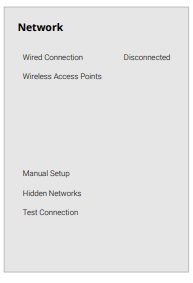
If you do not see your wireless network displayed, click on: More Access Points > Highlight your wireless network > Enter in the password > Connect
TIP: You can display your photos in Fullscreen. Select the photo, press OK, then highlight Fullscreen and press OK.
Changing the Manual Setup Settings
- Advanced users can fine-tune the network settings using the Manual Setup feature. The security settings on your router may require you to enter the TV's MAC address
To change advanced network settings: Menu > Network > Manual Setup > DHCP > Of
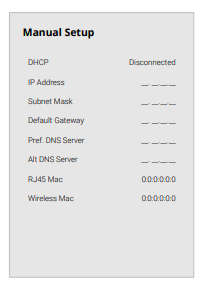
- Use the Navigation and OK buttons to adjust each setting:
- IP Address — The IP address assigned to the TV.
- Subnet Mask — The subnet Exit 2D.
- Default Gateway — Your network’s default gateway address.
- Pref. DNS Server — Your preferred domain name server address.
- Alt. DNS Server — Your alternate domain name server address.
- Use the Navigation buttons on the remote to highlight Save and press OK.
To find the TV’s MAC address: Menu > Network > Manual Setup
You can find your TV's MAC address at the bottom of the list. The MAC addresses for the connections in use are displayed:
- RJ45 MAC — The Ethernet or RJ45 MAC address may be needed to set up your network when you have connected the TV to your network when you have connected the TV to your network with an Ethernet (Cat 5) cable.
- Wireless MAC — The Wireless (Wi-Fi) MAC address may be needed to connect your TV to your network with Wi-Fi.
Connecting to a Hidden Network
- To connect to a wireless network whose network name (SSID) is not being broadcast: Menu > Network > Hidden Network > Enter the Access Point Name > Connect > Enter in the password
Testing Your Network Connection

- To test your network connection: Network Menu > Test Connection
SETTING TIMERS
When activated, the TV’s timer will turn the TV off after a set period of time.
To setup a sleep timer: Menu > Timers
Use the Left/Right Navigation buttons on the remote to highlight the period of time after which you want the TV to go to sleep: 30, 60, 90, 120, or 180 minutes. If you don’t want the sleep timer to activate, change the setting to Off.
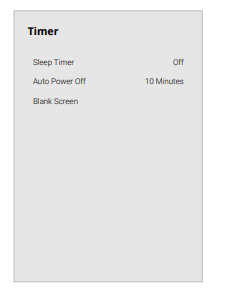
Setting the Auto Power Off Feature
- To help save energy, your TV is set by default to turn off after 10 minutes without a video or audio signal. This feature can be deactivated.
- To set the Auto Power Off feature: Menu > Timers > Auto Power Off > Off
Using the Blank Screen Feature
- To help save LED life, your TV screen can turn on or off while audio is streaming.
- To use the Blank Screen feature: Menu > Timers > Blank Screen
- To exit Blank Screen, press any key (except the volume and mute keys).
SETTING UP CHANNELS
You can use the TV’s Channels menu to:
- Find channels
- Select channels to skip
- Select analog audio mode
- Select the language for digital audio
- Set parental controls
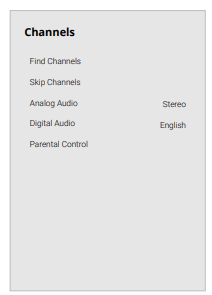
Scanning for Channels
The TV may need to scan for channels before it can display programs and their associated information. A channel scan is required for free over-the-air channels (using an antenna) and cable channels from an out-of-the-wall connection (without a cable box). Moving the TV to an area with different channels requires the TV to scan for channels again.
To perform an Auto Channel Scan: Menu > Channels > Find Channels
Wait until the channel scan is 100% complete. Highlight Done and press OK.
- If the channel scan is canceled, the channels that were already discovered are retained. A new channel scan will clear all channels.
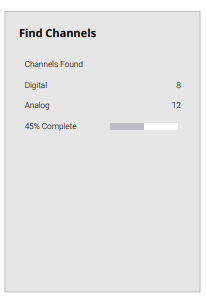
Skipping Channels
- After a channel scan is completed, you may find that some channels are too weak to watch comfortably. There may also be some channels you do not want to view. You can remove these channels from the TV’s memory with the Skip Channel feature.
WARNING: Channels that have been removed with the Skip Channel feature can still be viewed if the channel is entered using the Number Pad. If you wish to completely block a channel from being viewed, use the parental controls. See Locking and Unlocking Channels on page 26.
To remove a channel:
- From the CHANNELS menu, highlight Skip Channel, and press OK. The SKIP CHANNEL menu is displayed.
- For each channel you wish to remove, use the Up/Down Navigation buttons on the remote to highlight the channel and press OK. A √ appears to the right of each channel you select.

LISTENING TO ALTERNATE AUDIO
Changing the Analog Audio Language
Some analog over-the-air (free) and cable channels broadcast programs in more than one language. The TV’s Analog Audio feature allows you to listen to audio in an alternate language using Secondary Audio Programming (SAP).
WARNING: Not all programs are broadcast in SAP. The Analog Audio Language feature only works when the program being viewed is being broadcast with Secondary Audio Programming.
To use the Analog Audio feature: Menu > Channels > Analog Audio
- Stereo — More than one speaker channel is being used. Sounds may be dispersed through different speakers depending on how the audio is programmed.
- SAP (Secondary Audio Program) — Typically used for audio in a different language other than the native one used in the program.
- Mono — All speakers are producing the same sound; there is no distinction between left or right sounds.

To use the Digital Language feature: Menu > Channels > Digital Audio
Select the preferred audio language. Available languages or video description depend on the broadcast content.

USING PARENTAL CONTROLS
The TV’s parental controls allow you to prevent the TV from displaying certain channels or programs unless a PIN is used.
Accessing the Parental Controls Menu
- To access the Parental Controls menu you must first set up a system PIN: Menu > Channels > Parental Controls > Enter in PIN
TIP: To set a custom PIN passcode, see Setting a System PIN on page 34.
The Parental Controls menu only appears when:
- You are using the tuner to receive your TV signals, such as when you are using an antenna for Over-the-Air signals or when connected to cable TV directly from the wall (no cable box).
- You have a device connected using a composite video cable or a coaxial cable, such as a VCR, satellite or cable box, or DVR.
TIP: Other devices have their own parental control settings.
Enabling or Disabling Program Ratings
- To manage program content according to its rating, you must first enable the Program Rating feature.
- To enable or disable the Program Rating feature: Menu > Channels > Parental Controls > Locks > ON/OFF
Locking and Unlocking Channels
When a channel is locked, it cannot be accessed. Locking a channel is a good way to prevent children from viewing inappropriate material.
To lock or unlock a channel: Menu > Channels > Parental Controls > Channel Locks
Highlight the channel you want to lock or unlock and press OK.
- When a channel is locked, the Lock icon appears
 locked. The channel is not accessible unless the system PIN is entered.
locked. The channel is not accessible unless the system PIN is entered. - When a channel is unlocked, the Lock icon appears
 unlocked.
unlocked.
Blocking and Unblocking Content by Rating
A channel may sometimes broadcast programs that are meant for a variety of audiences (some for children and some for adults). You might not want to block the channel completely using a channel lock, but you can block certain programs from being viewed.
You can use the TV’s Rating Block feature to block content based on its rating.
To block or unblock content by its rating:
1. From the Parental Controls menu, highlight the content type you want to adjust and press OK:
- USA TV — USA television program broadcasts.
- USA Movie — USA movie broadcasts.
- Canadian English — Canadian English television program broadcasts.
- Canadian French — Canadian French television program broadcasts.
2. For each rating type you want to block or unblock, use the Navigation buttons to highlight the rating type and press OK.
- When the rating type is blocked, the Lock icon appears
 locked. Content with this rating and all higher ratings cannot be viewed.
locked. Content with this rating and all higher ratings cannot be viewed. - When the rating type is unblocked, the Lock icon appears
 unlocked. Content with this rating and all lower ratings can be viewed.
unlocked. Content with this rating and all lower ratings can be viewed. - If you want to block all unrated content, highlight Block Unrated Shows and use the Navigation buttons on the remote to select On.
USING THE INFO WINDOW
Press the INFO button one time to display:
- TV name
- Current input
- Picture mode
- Audio type
- Network name
- Time

*When TV speakers are off and Dolby Atmos content is passed through the TV to a sound bar or other audio device, the Dolby Atmos icon  will display with "Audio Out."
will display with "Audio Out."
SmartCast Home™
What is SmartCast Home?
SmartCast Home lets you discover, stream, and control your content like never before! Access top apps, like Netflix, Hulu, and Amazon Prime Video, by using the remote to easily browse and launch content directly from the home screen. SmartCast Home makes finding something to watch easy and fun.
How to Launch SmartCast Home
Begin streaming with SmartCast Home by:
- Press the V-Logo button
 or the Home button
or the Home button  on your remote. —or—
on your remote. —or— - Select SmartCast from the list of inputs.
What you can do with SmartCast Home
- Stream high quality entertainment.
- Launch top tier apps directly from the home screen.
- Unlock your photos and videos by mirroring your laptop or mobile device onto your TV.
- Rearrange apps on your home screen just the way you like it.
- Works with Google Assistant and other popular voice assistants.
Control your TV with the SmartCast Mobile™ App
Download the VIZIO SmartCast Mobile app and turn your smartphone into a remote to control and configure your TV.
Get it here, or visit vizio.com/smartcastapp on your device to download:

With SmartCast Mobile, you can:
- Power on/off devices, play/pause content, and modify advanced settings, all from the palm of your hand.
- Easily enter text onto your TV/display from your mobile device using a full keyboard.
- Browse and discover movies, TV shows, music, live streams, and more, across multiple apps at once.
- Access a quick look at show ratings, synopsis, cast, crew, clips, and other details.

WatchFree™
What is WatchFree?
VIZIO WatchFree takes your cord-cutting entertainment experience one step further! With the simple press of a button, enjoy free streaming TV with over 100 live TV channels to choose from – news, movies, sports, comedy, music and more. A built-in on-screen guide makes finding something to watch easier than ever.
And it’s all FREE – no fees, no subscriptions, or logins.
What you can do with WatchFree
- Stream over 100 live TV channels absolutely free – news, movies, sports, comedy, music and more.
- Navigate through channels, organized by genre, with an intuitive on-screen guide.
- Watch 1000’s of free movies from major studios.
- Watch the best of internet TV.
- No logins, subscriptions or transactions fees.
How to Launch WatchFree
To launch and begin watching entertainment offered on WatchFree:
- Push the WatchFree button or the INPUT button on your remote. —or—
- Simply select the WatchFree app logo from the SmartCast Home app row
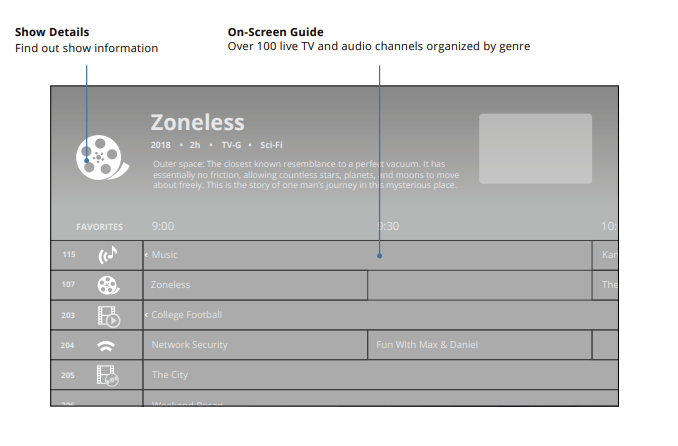
Playing USB Media
The USB Media Player allows you to connect a USB flash drive to your TV and play music, video, or photos.

Preparing Your USB Drive to Play USB Media
To display USB media, you must first save your videos onto a USB flash drive:
- The USB flash drive must be formatted as FAT32.
- Files on the USB flash drive must end in a supported file extension ( .mp3, .jpg, etc).
- The player is not designed to play media from external hard drives, MP3 players, cameras, or smartphones.
Displaying USB Media
To display your USB media:
- Connect your USB flash drive to the USB port on the side of the TV.
- The TV will recognize the USB. Use the Navigation Keys on the remote to select the content you want to play. —or—
- Select USB from the bottom streaming icons on the SmartCast HomeSM page.
TIP: You can display your photos in Fullscreen. Select the photo, press OK, then highlight Fullscreen and press OK.
Removing the USB Drive from the TV
To safely remove your USB flash drive from the TV:
- Turn the TV off.
- Disconnect your USB flash drive from the USB port on the side of the TV.
Playing USB Media: Music
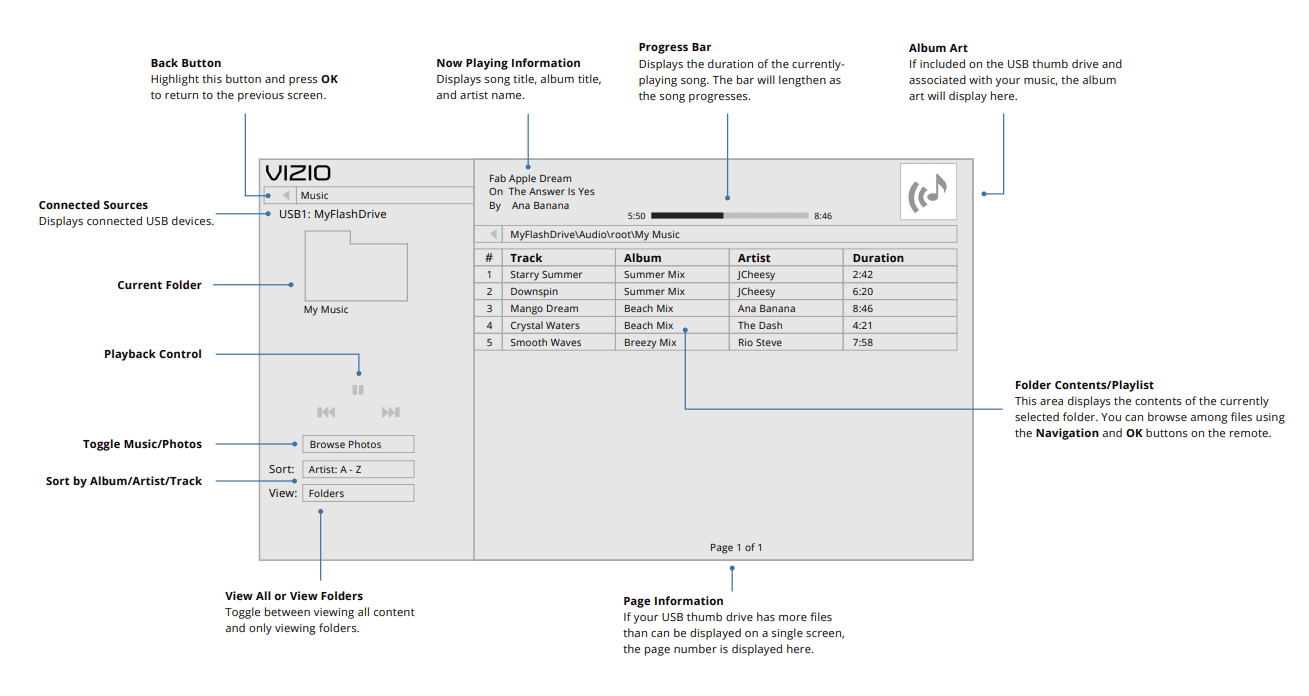
Playing USB Media: Video

Playing USB Media: Photo

Troubleshooting
Help Topics
1. The remote is not responding.
- Make sure the batteries are properly inserted matching the - and + symbols.
- Replace the batteries with fresh ones.
2. The TV displays “No Signal.”
- Press INPUT button on the remote control to select a different input source.
- If you are using cable TV or antenna connected directly to the TV, scan for channels. See Scanning for Channels on page 24.
3. There is no power.
- Ensure the TV is plugged into a working electrical outlet.
- Ensure the power cable is securely attached to the TV.
- Press the Power/Standby button on the remote or on the back of the TV to turn the TV on.
4. The power is on, but there is no image on the screen.
- Ensure all cables are securely attached to the TV.
- Ensure all devices are connected correctly. Devices differ; see your device’s user manual for details.
- Adjust Brightness, Contrast, or Backlight. See Adjusting the Picture Settings on page 16.
- Press the INPUT button on the remote to select a different input source
5. The sound is flat or dialog is not audible.
- Turn off Volume Leveling. See Adjusting the Audio Settings on page 21.
6. Where do I find information on the accessibility features of this product and other VIZIO products?
- Please visit vizio.com/accessibility,
- Email us at: [email protected], or
- Give us a call at 1-877-698-4746.
7. How do I stream apps like Netflix to my VIZIO SmartCast™ TV?
- Download and open a Chromecast-enabled apps on your mobile device. Then tap the Cast button.

8. The colors on the TV don’t look right.
- Adjust the Color and Tint settings in the Picture menu. See Adjusting the Picture Settings on page 16.
- Select a pre-set picture mode. VIZIO recommends selecting Calibrated.
- Check all cables to ensure they are securely attached.
9. There is no sound.
- Press Volume Up on the remote control.
- Press the Mute button on the remote to ensure mute is off. • Check the audio settings. See Adjusting the Audio Settings on page 21.
- Check the audio connections of external devices (Blu-ray player, game console, cable/satellite box) that are connected to the TV.
- If you are using an antenna, the signal strength of the channel may be low. Ensure your antenna is connected securely to the TV and move the antenna around the room or close to a window for the best signal
10. The image quality is not good.
- For the best image quality, view high-definition programs using digital sources. Connect your devices with HDMI cables.
- If you are using an antenna, the signal strength of the channel may be low. Ensure your antenna is connected securely to the TV and move the antenna around the room or close to a window for the best signal.
11. The picture is distorted.
- Move the TV away from electrical appliances, cars, and fluorescent lights.
- Ensure all cables are securely attached.
12. The TV image does not cover the entire screen.
- If you are using TV, AV, or Component with 480i input, press the WIDE
 or PIC button on the remote to change the screen mode.
or PIC button on the remote to change the screen mode.
13. The TV has pixels (dots) that are always dark.
- Your HD TV is precision-manufactured using an extremely high level of technology. However, sometimes pixels may not display correctly. These types of occurrences are inherent to this type of product and do not constitute a defective product.
14. The buttons on the remote aren’t working.
- Ensure you are only pressing one button at a time.
- Point the remote directly at the TV when pressing a button.
- Replace the remote batteries with new ones. See Replacing the Batteries on page 11.
15. I see “noise” or static on the screen.
- When your TV’s digital capabilities exceed a digital broadcast signal, the signal is up-converted (improved) to match your TV’s display capabilities. This up-converting can sometimes cause irregularities in the image.
- If you are using an antenna, the signal strength of the channel may be low. Ensure your antenna is connected securely to the TV and move the antenna around the room or close to a window for the best signal.
16. When I change input source, the TV image changes size.
- The TV remembers the viewing mode on each input source. If the viewing mode on the new input source differs from the one on the input source you switch from, the difference may be noticeable.
- See Changing the Screen Aspect Ratio on page 15.
17. How do I download the VIZIO SmartCast Mobile™ App?
- Make sure your phone or tablet is connected to a Wi-Fi network. Open a browser on your phone or tablet.
- Navigate to vizio.com/smartcastapp and follow the on-screen instructions to download the VIZIO SmartCast Mobile™ App.
18. How do I change the Inputs?
- Press the INPUT button on the back of the TV to cycle through the Inputs.
- Press the INPUT button on the basic remote to cycle through the Inputs.
- Make sure the VIZIO SmartCast Mobile app is installed on your phone or tablet. Open the VIZIO SmartCast Mobile app. Tap on the Device list and select your TV. Tap on the Input key and select the Input of your choice.
19. How do I connect to my Wi-Fi network?
- On your TV remote, press the Menu button then go to Network > Select your Wi-Fi name > Enter password.
- Open the VIZIO SmartCast Mobile™ app on your phone or tablet. Tap on the device list and select your Display.
- Tap on the Settings icon > Network > Wireless Access Points. Select your Wi-Fi network from the list, enter the Wi-Fi password, and tap Connect.
20. How do I exit Demo Mode
- Press and hold the INPUT button on the back of the TV to exit the demo mode.
21. How do I watch Cable/Antenna TV channels?
- If you subscribe to cable or satellite, simply connect an HDMI cable (not included) to the receiver.
- If you use external antennas to watch local broadcast channels, use a coaxial cable to connect.
22. Some of my Channels are missing.
- Press the MENU button on your TV remote and select the channels option. Then select Find Channels.
- Open the VIZIO SmartCast Mobile app on your phone or tablet.
- Click on: Control > Your TV/Device Name > Settings Icon > Channels > Find Channels.
23. How do I disable/enable Viewing Data?
- Press the MENU button on your remote and select the System option. Select Reset & Admin. Then select Viewing Data to turn the feature on or off.
- Open the VIZIO SmartCast Mobile app on your phone or tablet.
- Click on: Control > Your TV/Device Name > Settings Icon > System > Reset & Admin > Viewing Data Slider.
24. The television will not turn on using Alexa or Google Assistant.
- Ensure the television is in Quick Start mode.
- Tap on Menu > System > Power Mode > Quick Start.
25. How do I know I am getting 4K resolution or HDR content such as Dolby Vision?
- As you are watching content on the television, press the INFO button on the remote or VIZIO SmartCast Mobile app. You will see the current resolution being displayed along with the version of video.
- HDR will show as a Dolby Vision icon, HDR10 or HLG.
See other models: D50x-G9 D65x-G4 D43-E2 M55-F0 P659-G1
